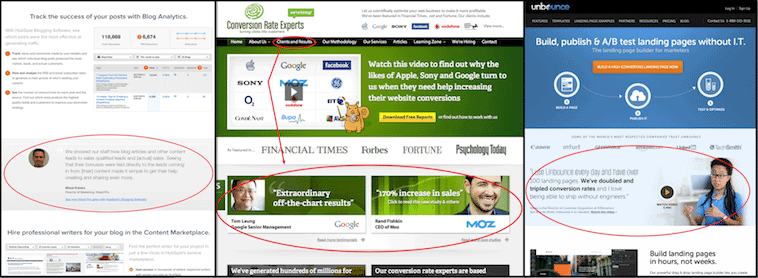2. Learn to Recognize Quality Testimonials
Not all testimonials are created equal, and quality testimonials are not just about rave reviews. Testimonials that will actually influence your prospects to make positive decisions with the most authority are about the right kind of rave reviews.
To let current customers speak to your prospects on your behalf, you need to strategically choose testimonials that:
- Emphasize benefit statements—meaning they address your specific customer pain points
- Validate your own assertions—meaning they endorse the key benefits you claim
- Are credible—meaning they are from real people (when you can, include full names, hometowns, or similar qualifiers—every “extra” helps personalize the pitch)
- Are comparative—meaning they favorably mention your product vs. the competition (if this is something you specifically run up against often, of course).
For Example, let’s imagine you own a high-end design firm, LuxuryLooks. As the owner, you’ve obtained two testimonials recently and you’re excited to make one of them live on your website:
- Customer A wrote: “LuxuryLooks is my favorite firm to work with and I love their recommendations. I’ll definitely be back for my next house renovation project!”
- Customer B wrote: “LuxuryLooks made my new house feel like home. They met me onsite, brought a breadth of samples, took their time advising, met my budget, and their customer service team was more efficient than the other firms I spoke to in the Seacoast area.”
The winning testimonial should be clear. Though customer A’s review is loyal, it’s not meant for the trophy case either. It lacks substance, specifics, and differentiators. Meanwhile, customer B offers multiple value propositions—comfort, client interface, patience, budget and service efficiency—and even manages to politely reduce the competition.You couldn’t say it better yourself.
But where you put your testimonials on your website matters when it comes to getting the most mileage out of them.
3. Understand How to Strategically Position Your Testimonials
In the days of old, website testimonials usually lived in a testimonials page, lumped together all higgledy-piggledy. Today, we recognize the pitfall of this strategy: It’s not a strategy at all.
Since reviews can create a 74% increase in product conversions, you want to make sure you are using your testimonials properly. Taken alone, a testimonials page devalues the overall quality and effectiveness of your customers’ reviews and comments and decreases the power of its social proof. This is not to say you cannot archive reviews here, but you have to remember that the substance of your testimonials—just like your blog posts, eBooks, or other inbound marketing tools—is most effective when it exists harmoniously with the content it is relative to.
Whether we are talking about a homepage or product page in an e-commerce website, a testimonial directly related to this page’s offerings will be far more effective if the user can experience it right then, right there. This is how a testimonial goes from being an independent sales tool to truly strengthening a website’s conversion funnel and overall strategy.
Think of it this way: As the consumer engages with your site, your job is to encourage them to follow a strategic conversion path, and this path should have a funnel effect—wide at the top, narrow at the bottom. This is designed to carefully condition the user to make more informed, specific, and substantial decisions at key junctures along the way. In this funnel, think of your testimonials as the icing on your conversion cake; it should entice users to take a big bite at exactly the right moment.
For example, whether a prospect is looking to work with a new high-end interior design firm or they just aren’t sure which coffee thermos to buy from an online store, when they land on your homepage or your product page, you want to ensure that they clearly see a current customer’s testimonial on this page. If this testimonial only lives on a testimonials page, the likelihood that they will find it is slim, and its relevancy will be diminished even if they do. When a current customer said your interior design firm was the best or the red 20 oz. thermos you sell is the perfect purchase (and precisely why), it’s your job to make sure your prospects receive this information when and where it counts!
Hubspot does a great job of placing their testimonials in context on all their pages (we chose to highlight their blogging software, of course); so do the gurus at Conversion Rate Experts (homepage); and the marketing team at Unbounce (homepage video) is no slouch either.
Click the links above, or check out the screenshots below to see these companies using testimonials strategically. In every example, the testimonials are big, bold, and deliberately situated:
So, before you start beating your chest and shouting about your amazing prices, reliable services, or quality products, remember that your prospects might be thinking, “says who?”
As a business owner, you have to find ways to back all your salesy superlatives and thoughtful copy before it can mean much to the consumer. If your clients can do the selling for you via quality testimonials that you strategically position, then there’s a good chance you’ll hush the buyer beware attitudes of your prospects without ever appearing desperate.
How do you use testimonials? Let us know in the comments section; or if you need help strategizing your inbound marketing strategy, contact us!


![How to Make a Content Style Guide as Unique as Your Brand [w/ Free Template!] 6 content-style-guide](https://vitaldesign.com/wp-content/uploads/2018/05/content-style-guide-818x596.jpg)